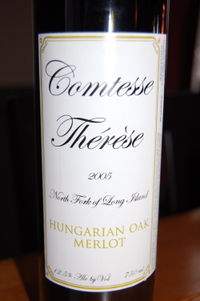Comtesse Therese 2005 Hungarian Oak Merlot
 I know that the oak debate, among winemakers and wine geeks, usually centers American vs. French oak, with everyone arguing passionately in favor or their preferred barrel. But, as much as I tend to prefer the more expensive French cooperage, I really enjoy what a third type of oak, Hungarian oak, brings to the table as well.
I know that the oak debate, among winemakers and wine geeks, usually centers American vs. French oak, with everyone arguing passionately in favor or their preferred barrel. But, as much as I tend to prefer the more expensive French cooperage, I really enjoy what a third type of oak, Hungarian oak, brings to the table as well.
That spice, and more understated raw oak flavors are on display in Comtesse Therese 2005 Hungarian Oak Merlot ($18), an extremely approachable, enjoyable red.
The nose is playful and spicy, blending bright red berries — cherries and raspberries — with violets, black pepper and subtle brown spices.
The berry flavors are a bit darker on the juicy palate, with blackberry joining the party. That Hungarian oak brings layers of black pepper and spice, and also imparts hints of toasty oak and vanilla. There is plenty of fruit here to balance the oak.
The tannins are super-ripe tannins and just a little grippy. A bit more grip would be nice, but for drinking today and over the next couple of years, there's enough.
At $18, this one is well priced too.
Grape(s): 100% merlot
Producer: Comtesse Therese
AVA: North Fork of Long Island
Price: $18
Rating:
(3 out of 5 | Recommended)
(Ratings Guide)
















Lenn,
There’s an awful lot in your writeup about how the oak influences the wine. Sounds very enjoyable and easy drinking, but I tend to prefer wines that are expressions of their place, not their barrel.
Evan: Sounds like a man who is lucky enough to live in Finger Lakes wine country, where riesling rules, since riesling sets a magnifying glass squarely on its vineyard location.
The oak does nice things to this wine, but it doesn’t overpower, which is one of the things that I tend to like about Hungarian oak. This is still recognizable as a Long Island merlot. It’s not bludgeoned.
Lenn,
Fair enough! But the more I taste LI Merlot, the more I believe the hype. However, it’s still hard for me to describe in any short, specific way the sense of place that is found in a LI Merlot. How would you describe it?